Key takeaways:
- Adopting diverse music education methods, such as Orff and Kodály, enhances student engagement and caters to different learning styles.
- Real-world applications, like songwriting for community events, deepen students’ connections to music and foster creativity.
- Motivation through personal interests significantly boosts student confidence, persistence, and a sense of community in the classroom.
- Measuring success through student feedback and performance outcomes helps to create a supportive and expressive learning environment.
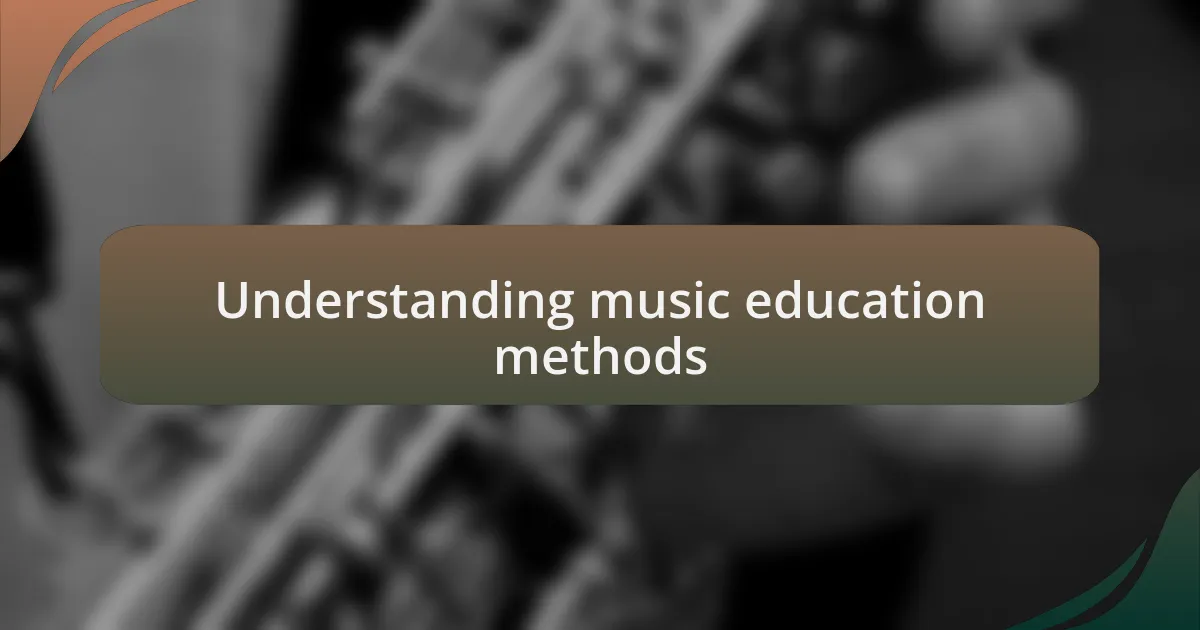
Understanding music education methods
Understanding music education methods requires a deep dive into various pedagogical approaches, such as Orff, Kodály, and Dalcroze. I remember a time when I adopted the Orff method in my classroom, using playful instruments like xylophones and drums to engage my students. Watching them learn rhythms through movement was a revelation; it made me realize how music truly comes alive when students are actively involved in the learning process.
Each of these methods presents unique advantages, catering to different learning styles and emotional needs. For instance, the Kodály approach places a strong emphasis on singing and ear training. I’ve seen students transform through this method; their confidence bloomed as they discovered the joy of music through their own voices. Isn’t it fascinating how the right approach can ignite a passion for music in a child who once felt intimidated by it?
Furthermore, incorporating real-world applications into these methods enhances their effectiveness. I often ask my students how the music we’re learning connects to their lives. Their responses can be eye-opening! When they recognize the relevance of what they’re learning, their enthusiasm increases. Music education is not just about notes and rhythms; it’s about cultivating a lifelong appreciation for art and creativity.
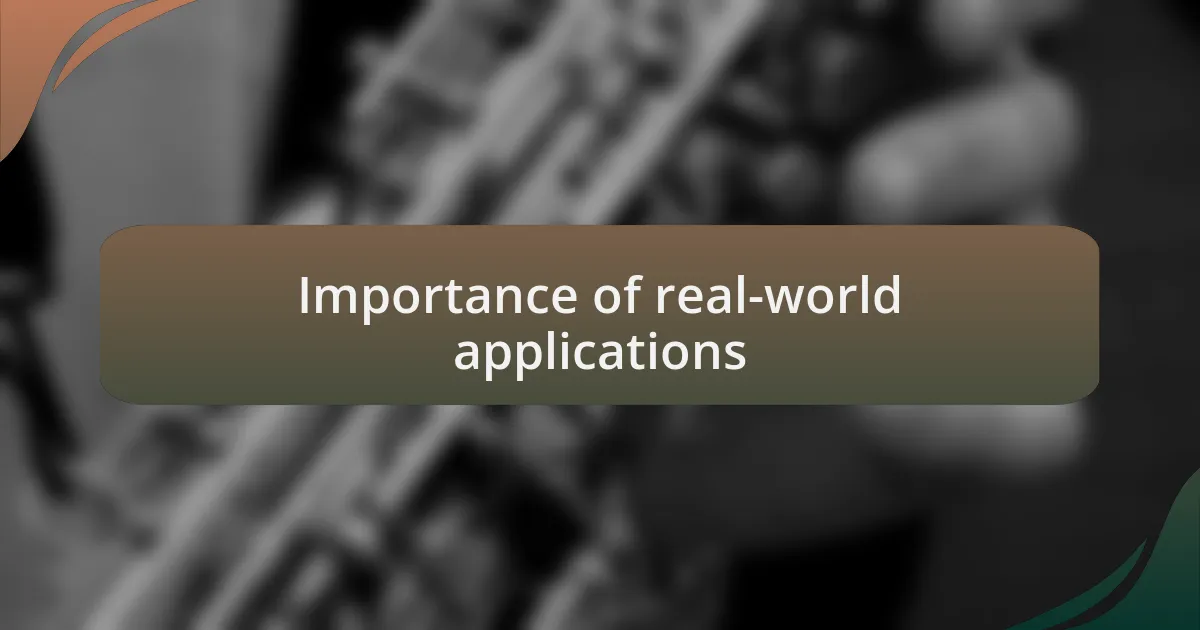
Importance of real-world applications
Real-world applications in music education provide students with the context they crave. I recall a time when I introduced a project involving songwriting for a local community event. The excitement was palpable as students realized their work could contribute to something tangible. Suddenly, music was no longer an abstract concept; it became a means of expression that had real significance in their lives.
When students see how music intersects with their interests, it sparks a passion that goes beyond the classroom. I once had a student who loved video games. By integrating game soundtracks into our lessons, I noticed a shift in his engagement. He became more invested, not just in playing the music, but in understanding how sound shapes experiences. It’s moments like these that highlight how relevant applications can transform learning into something profoundly meaningful.
Moreover, real-world connections foster creativity and critical thinking. I often encourage my students to explore musical genres from different cultures and relate them to current societal issues. This approach not only broadens their musical horizons but also connects them to the world around them. Isn’t it empowering for students to recognize their ability to influence culture through music? By understanding music’s role in the larger social context, students become not just musicians, but informed and engaged global citizens.
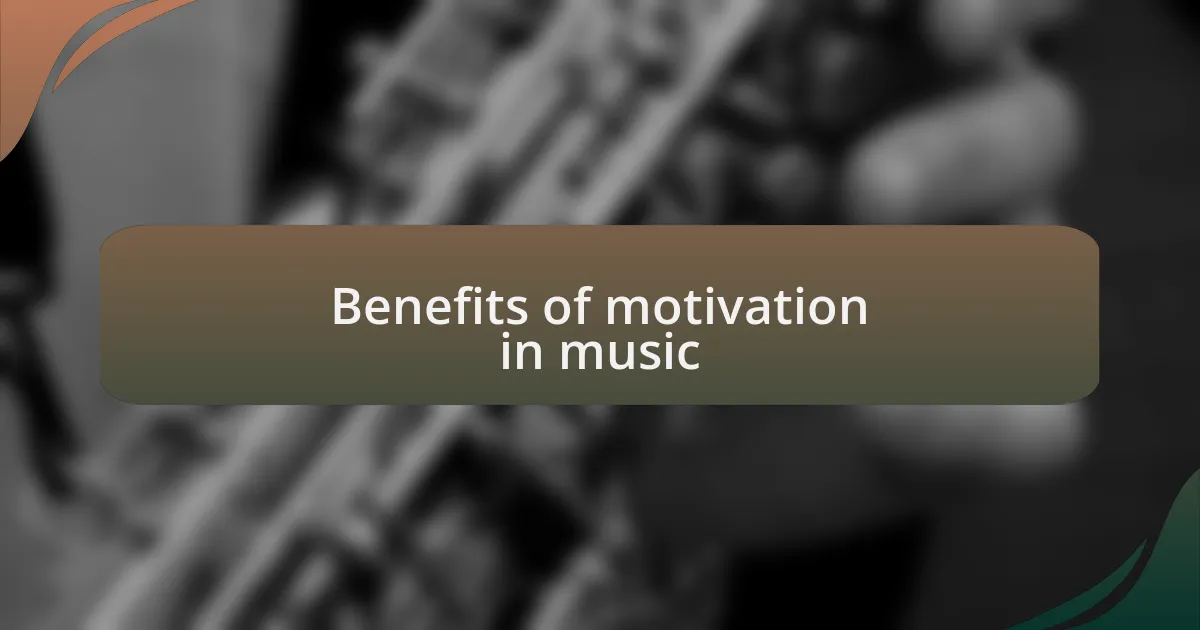
Benefits of motivation in music
Motivation in music education has profound benefits that extend beyond mere enjoyment. I remember a student who initially struggled with confidence; she would shy away from participating in class. Once I began incorporating her favorite pop songs into our curriculum and spotlighting her unique voice, she lit up. It became clear that when students are motivated by personal connections, their performance and commitment skyrocket.
Additionally, motivated students often exhibit a remarkable increase in perseverance. There was a young man in my class who faced significant challenges mastering the guitar. Yet, when we set specific goals tied to his aspiration of playing at a local open mic night, his dedication was inspiring. He practiced relentlessly, viewing each small improvement as a victory. Isn’t it fascinating how motivation can transform obstacles into exciting challenges?
Moreover, a motivated student body cultivates a vibrant classroom community. I have often found that when students collaborate on music projects, their collective enthusiasm creates an infectious energy. I witnessed this firsthand during a group composition session. The synergy that developed not only led to memorable pieces but also fostered friendships and teamwork. When students are excited about music, they naturally inspire each other; it’s a beautiful cycle of motivation that keeps the creativity flowing!
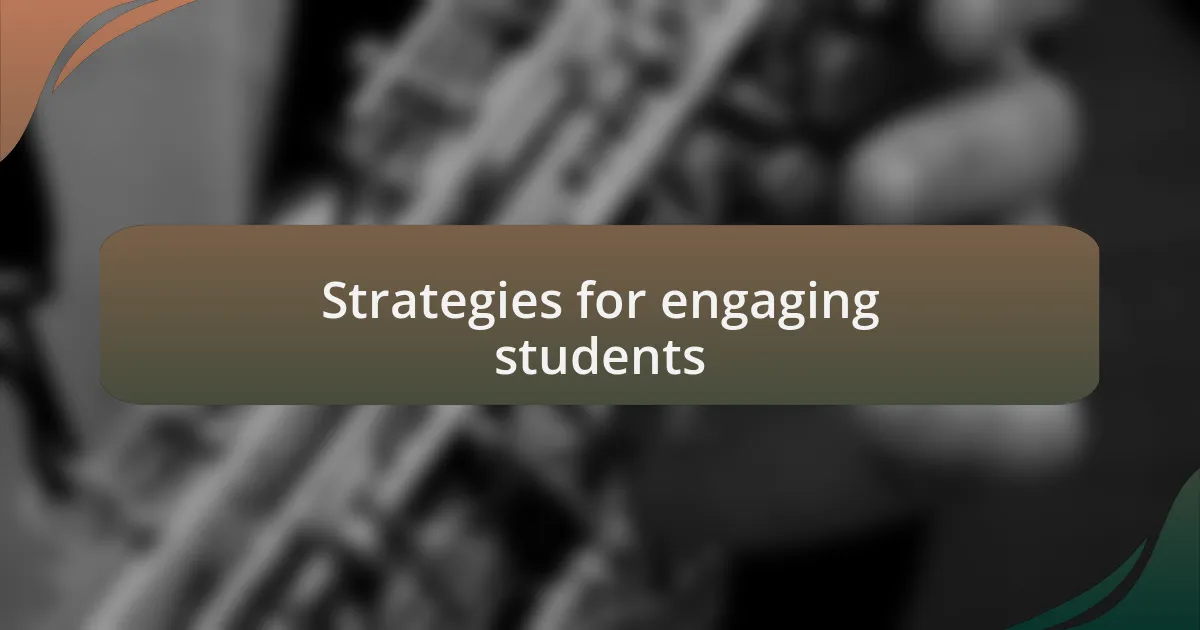
Strategies for engaging students
One effective strategy I’ve found for engaging students is linking their musical interests to the curriculum. I once had a class filled with students who were passionate about hip-hop. By introducing them to the history and cultural significance of the genre, I witnessed their enthusiasm surge. They began to see music not just as notes on a page but as a powerful form of expression. Isn’t it inspiring to watch students connect their lives to what they’re learning?
Another approach is to incorporate technology into lessons. For instance, I introduced music production software in a project where students created their own tracks. The excitement was palpable as they experimented with beats and lyrics. Suddenly, they weren’t just passive learners; they had become creators. Seeing their pride in their finished products reinforced the idea that music education can be both fun and relevant. Who doesn’t get a kick out of expressing themselves through their own creations?
Additionally, encouraging student collaboration can greatly enhance engagement. I remember organizing a classroom jam session where students had to work together to create a short piece. There was something magical about watching them bounce ideas off each other, blending different styles and skills. It fostered a sense of community and belonging, turning what could have been an isolating experience into a celebratory one. How often do we underestimate the power of collaboration in sparking creativity?
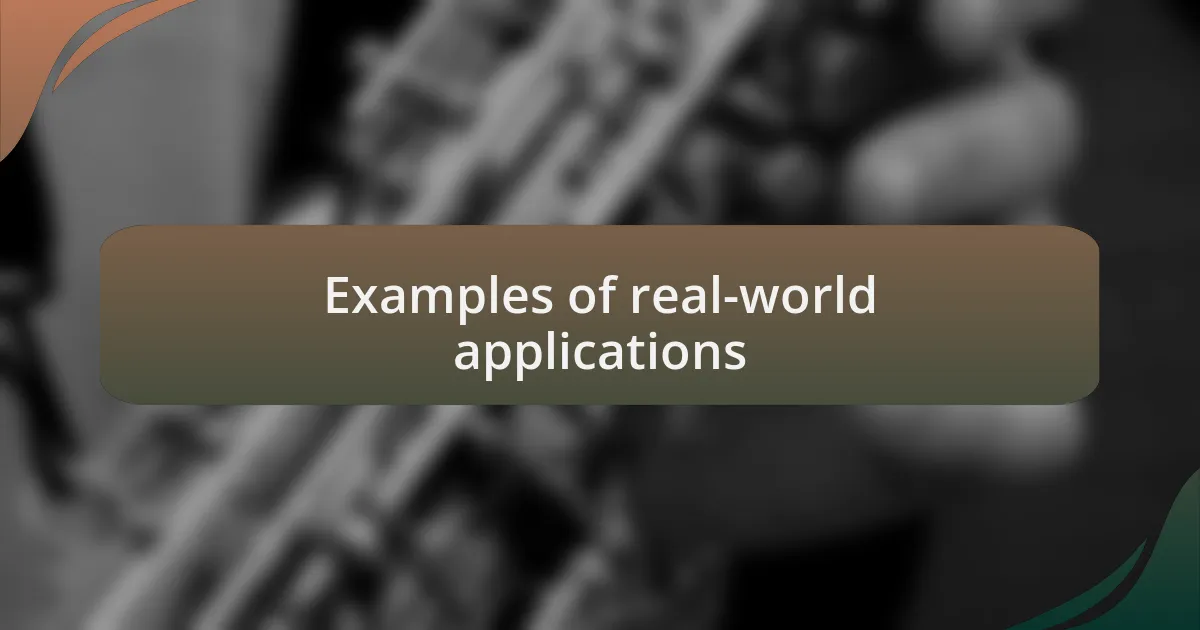
Examples of real-world applications
One of the most impactful real-world applications I’ve seen in the classroom is when students explore music therapy. I had a group that delved into how music can improve mental health. Watching them research real-life cases where music has helped individuals heal from trauma was eye-opening. It was heartwarming to witness their realization that music could potentially change lives—not just their own, but others as well. Have you ever thought about the profound impact music can have beyond the stage?
I also encourage students to investigate local musicians’ careers in our community. I recall inviting a local jazz artist to speak about their journey and the realities of making a living through music. Students were captivated, eager to ask questions about the challenges and triumphs of a performing artist. This direct interaction not only demystified the music profession but ignited their ambitions. Isn’t it exciting to realize that success in this field often springs from a deep passion paired with relentless effort?
Another rewarding project involved students composing original pieces for a local charity event. I remember the energy as they brainstormed themes and messages that resonated with the cause. Witnessing their dedication to creating music that could raise awareness and funds for a meaningful purpose really engaged their hearts. How powerful is it for students to understand that their creativity can make a tangible difference in the world?
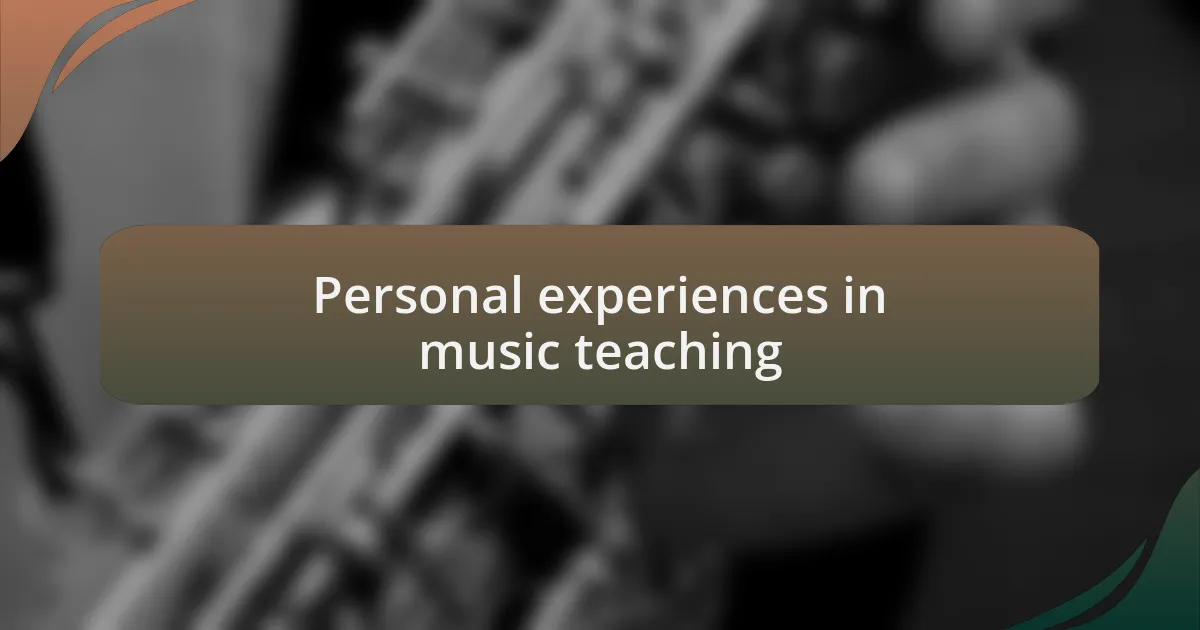
Personal experiences in music teaching
As a music teacher, I’ve had the privilege of seeing students connect with music on a deeply personal level. There was one instance when I introduced kids to songwriting by sharing my own struggles with expressing emotions through lyrics. Watching them open up about their own experiences was transformative. Have you ever noticed how powerful it is when students realize that their feelings can be expressed through their music?
In another memorable experience, I organized a small performance in which students collaborated with a local dance class. I clearly recall the moment when one shy student played an original piece for the dancers and witnessed the beautiful synergy between the music and movement. The joy and pride on their faces were unforgettable. It had me thinking—what other forms of creative collaboration might spark similar moments of self-discovery and confidence?
One of my most gratifying moments came when a student approached me, excited about a contemporary music genre I had introduced. They asked if they could present a project that blended their love of hip-hop with traditional instruments. It struck me how energizing it can be to allow students to take charge of their learning. Isn’t it fascinating how music can bridge generational and cultural gaps in ways we often underestimate?
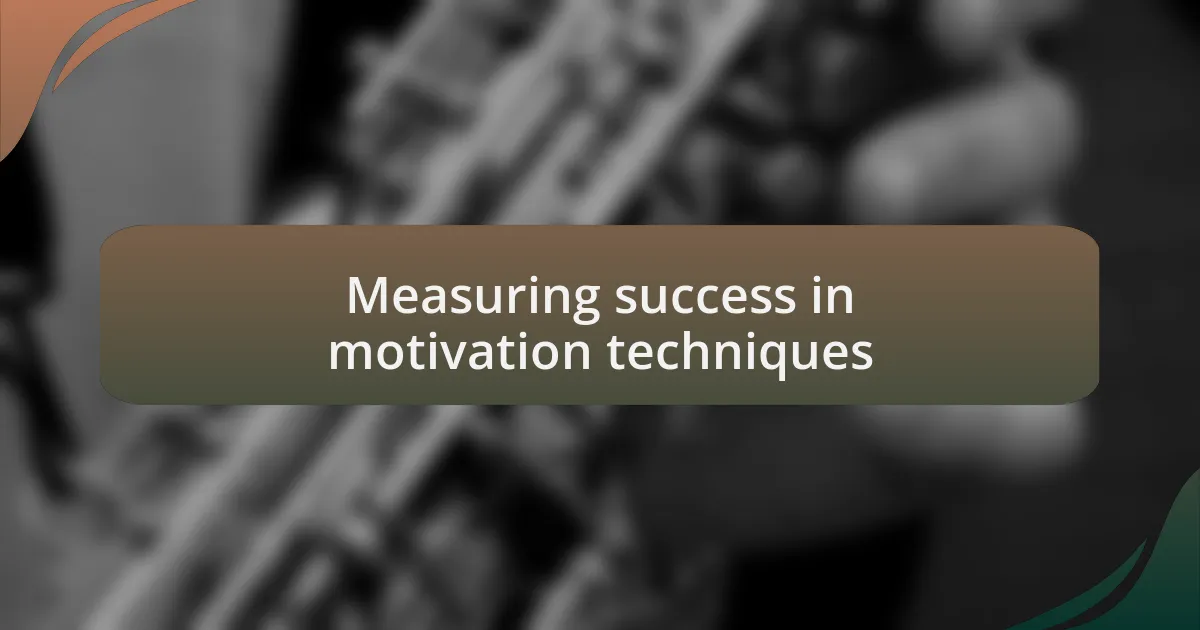
Measuring success in motivation techniques
To effectively gauge the success of my motivation techniques, I often turn to student feedback. I remember a time when I asked my class to reflect on their experiences after a project on improvisation. The enthusiastic responses indicating newfound confidence were a clear sign that my approach resonated with them. Have you ever noticed how powerful it can be to listen to your students’ voices?
In one instance, a student who typically struggled with participation expressed how much they enjoyed collaborating with peers during a group piece. Their eyes sparkled with excitement as they shared their thoughts. Tracking such moments helps me understand not only individual growth but also the collective spirit of the classroom. I’ve realized that motivation isn’t just about getting results; it’s about creating an environment where students feel empowered to express themselves.
I also rely on performance outcomes as a measure of success. When I see students pushing boundaries in their performances or excitedly sharing their musical projects, it tells me my efforts are paying off. One particular performance, where students incorporated their own compositions, showcased their creativity and passion beautifully. How do we know we’ve truly engaged students if they don’t take the initiative to share their music with the world?